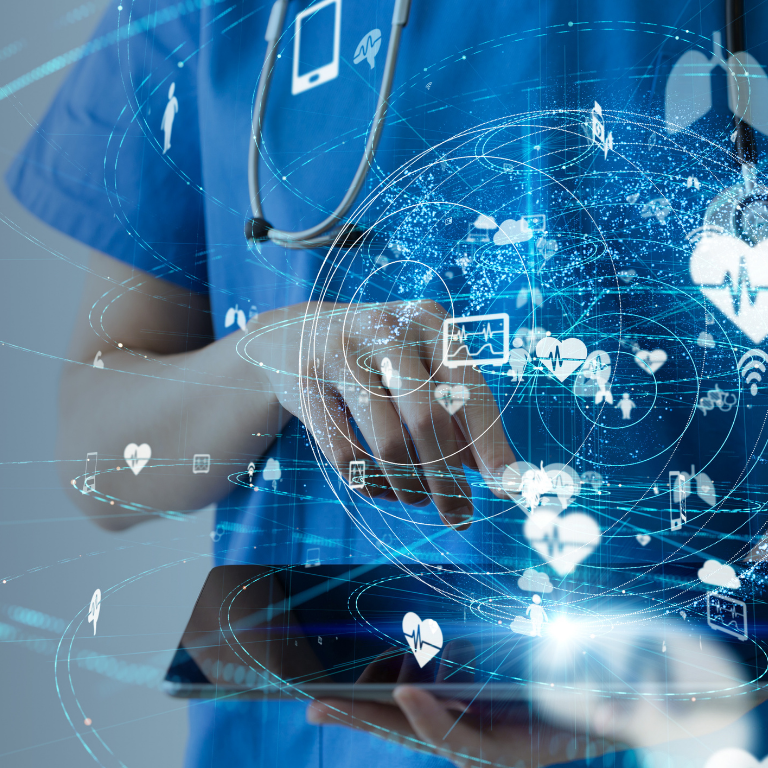What is The Internet of Medical Things?
Simply put, the Internet of Medical Things (IoMT) is the network of Internet-connected medical devices, hardware infrastructure, and software applications used to connect healthcare information technology. So basically, when talking about IoMT we are referring to a connected infrastructure of medical devices, software applications, and health systems and services.
The importance of IoMT in the Healthcare Industry
Now, since the Pandemic started, we have experienced a growing dependency on technology in the healthcare industry, which demands continuous innovation to deal with the new health dangers. On that note, the IoMT has also increased its importance during the COVID-19 pandemic, allowing providers to deliver quality care at a distance. According to a recent Deloitte survey, the overall IoMT market was expected to go from $41 billion in 2017 to $158 billion by 2022, and it is expected to grow at a CAGR of 29.9% to reach $322.2 billion by 2025.
But how exactly is IoMT impacting and transforming healthcare? Here are 3 examples:
Remote patient monitoring
This is the most common application of IoMT, where remote devices can automatically collect health metrics—like blood pressure, temperature, oxygen levels, heart rate, etc. This allows health providers to collect patient data, eliminating the need for physical contact, or for patients to collect data themselves. Also, by collecting the patient’s metrics, algorithms may be used to analyze the data to recommend treatments or generate alerts.
Continuous Glucose Monitoring
For the more than 30 million people living with diabetes, glucose monitoring has traditionally been difficult. The challenge goes beyond the inconvenience of manually recording the glucose levels, the real difficulty is to accurately report these levels as they fluctuate widely, making it complicated to detect a problem. Now, IoMT devices help address these challenges by providing continuous, automatic monitoring of glucose levels in patients. This way Glucose monitoring devices eliminate the need to keep manual records and can alert patients when glucose levels are problematic.
Depression and mood monitoring
Information about a patient’s mood is another type of data that has traditionally been difficult to collect making it harder to identify depression symptoms. This happens because, even if the health provider consults the patient regarding their feelings, it’s hard to anticipate sudden mood swings, not to mention that often patients don’t accurately report their feelings.
“Mood-aware” IoMT devices solve these challenges by collecting and analyzing data such as heart rate and blood pressure, then the devices can infer information about a patient’s mental state. Some advanced IoMT devices for mood monitoring can even track data such as the movement of a patient’s eyes.
The future of Medicine is here
The advantages of new software development and IT within healthcare are clear as water. The ability of medical equipment to share real-time data opens up a wide number of possibilities and important advantages for both patients and healthcare providers such as:
- Improvement of care outcomes
- Streamlining of Remote Patient Monitoring Services
- Reducing the cost of care, especially in Post Acute Care Settings (PAC)
- Access to real-time patient health data
- Remote monitoring of the health and performance of connected devices
And the best part…IoMT devices are already part of people’s lives. Most consumer mobile devices are now equipped with connectivity technologies that enable them to communicate with IT systems seamlessly.
This means that both doctors and patients can take advantage of IoMT and leverage its potential through everyday devices without investing in expensive monitors that can interface with medical devices.
However, while the IoMT has the potential to help alleviate some of the challenges facing healthcare such as cost, access, and care coordination, this generation of data must turn into actionable insight.
The healthcare sector must develop new strategies to harness the data collected through millions of IoMT and use it to make their business and operating models relevant and competitive to the new era we are living in.
About ITJ
ITJ is devoted to serving fast-growing and high-value market sectors, particularly the Internet of Medical Things (IoMT), working with innovative medical device companies looking to improve people’s lives. With a unique BOT (build, operate, and transfer) model that sources only the best digital talent available, ITJ enables companies in the US to create technology centers of excellence in Mexico. For more information, visit www.itj.com.


